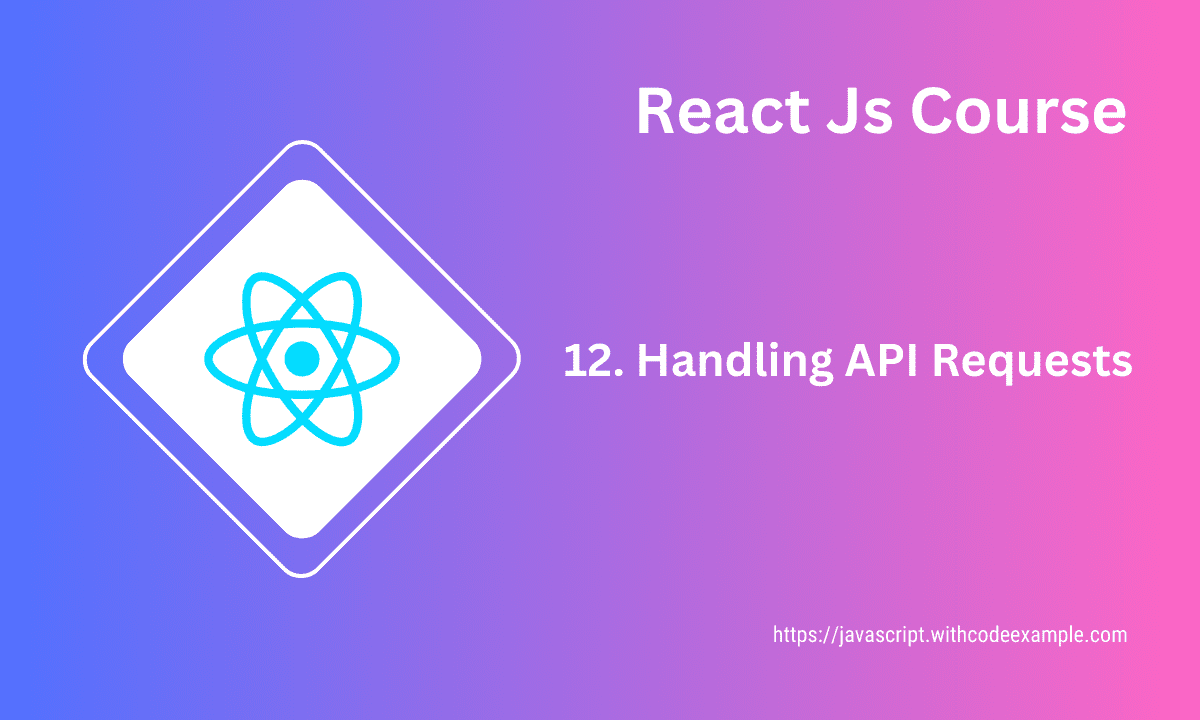Handling API requests and data in a React application involves making asynchronous calls to APIs, fetching data, and updating the component’s state accordingly. Here’s a general outline of how you can handle API requests and data in a React application:
Making API requests in React
You can use the fetch API, axios, or other HTTP client libraries to make API requests. For the sake of this example, let’s use the fetch API.
import React, { useState, useEffect } from 'react';
const App = () => {
const [data, setData] = useState([]);
const [loading, setLoading] = useState(true);
const [error, setError] = useState(null);
useEffect(() => {
fetch('https://api.example.com/data')
.then(response => response.json())
.then(data => {
setData(data);
setLoading(false);
})
.catch(error => {
setError(error);
setLoading(false);
});
}, []);
if (loading) {
return <p>Loading...</p>;
}
if (error) {
return <p>Error: {error.message}</p>;
}
return (
<div>
{data.map(item => (
<div key={item.id}>{item.name}</div>
))}
</div>
);
};
export default App;
In this example, the useEffect hook is used to make an API request when the component mounts. The useState hooks manage the loading state, fetched data, and error state.
Using fetch or third-party libraries
When it comes to making API requests in a React application, you have the choice between using the built-in fetch API or third-party libraries like axios. Both approaches have their advantages and drawbacks, and the choice depends on your specific use case and project requirements. Let’s compare the two:
Using fetch API:
Advantages:
-
Built-in: The
fetchAPI is built into modern browsers, so you don’t need to install any additional dependencies. -
Minimal Setup: Since it’s a native browser feature, you don’t need to add extra dependencies to your project.
-
Promises: The
fetchAPI uses Promises, making it compatible with modern JavaScript’s asynchronous patterns.
Drawbacks:
-
Low-Level: The
fetchAPI is relatively low-level and lacks some features that might be helpful, such as automatic JSON parsing. -
No Request Cancellation:
fetchdoesn’t provide built-in support for canceling requests, which can be important for user experience. -
Handling Errors: While error handling is possible with
fetch, it can be verbose and less intuitive than some third-party libraries.
Using Third-Party Libraries (e.g., axios):
Advantages:
-
Feature-Rich: Third-party libraries like
axiosprovide features like automatic JSON parsing, request/response interceptors, and request cancellation. -
Request Cancellation: Libraries like
axiosoffer built-in support for canceling requests, which is useful for managing user interactions. -
Concise Error Handling:
axiosmakes error handling more concise and standardized.
Drawbacks:
-
Extra Dependency: Adding a third-party library increases your project’s dependencies and bundle size.
-
Learning Curve: You’ll need to learn the specific syntax and features of the chosen library.
Which to Choose:
-
If you want a lightweight solution, don’t require extensive features, and prefer using native browser APIs,
fetchis a good choice. -
If you need more advanced features like automatic JSON parsing, request cancellation, and interceptors, and you’re comfortable adding an extra dependency, consider using a third-party library like
axios.
Example of Using axios:
import React, { useState, useEffect } from 'react';
import axios from 'axios';
const App = () => {
const [data, setData] = useState([]);
const [loading, setLoading] = useState(true);
const [error, setError] = useState(null);
useEffect(() => {
axios.get('https://api.example.com/data')
.then(response => {
setData(response.data);
setLoading(false);
})
.catch(error => {
setError(error);
setLoading(false);
});
}, []);
if (loading) {
return <p>Loading...</p>;
}
if (error) {
return <p>Error: {error.message}</p>;
}
return (
<div>
{data.map(item => (
<div key={item.id}>{item.name}</div>
))}
</div>
);
};
export default App;
In summary, both fetch and third-party libraries like axios have their merits. If you’re looking for a quick and minimal solution, fetch is a solid choice. If you need more features and a streamlined development experience, consider using a third-party library like axios.
Handling asynchronous operations with async/await
async/await is a powerful feature in modern JavaScript that allows you to work with asynchronous operations in a more synchronous-like manner. It’s especially useful when dealing with tasks like making network requests, reading/writing files, or handling any operation that might take time to complete without blocking the main thread. Here’s a basic overview of how to use async/await in JavaScript:
- Async Function Declaration:
To use async/await, you need to define an async function. An async function always returns a promise implicitly, and you can use the await keyword inside it to pause the execution of the function until a promise is resolved.
async function fetchData() {
// Asynchronous code goes here
}
awaitKeyword:
Inside an async function, you can use the await keyword before a promise to pause the execution of the function until the promise is resolved. This allows you to write asynchronous code that looks similar to synchronous code.
async function fetchData() {
const response = await fetch('https://api.example.com/data');
const data = await response.json();
return data;
}
In this example, fetchData fetches data from an API, but the use of await makes it seem like a linear, synchronous operation.
- Error Handling:
You can use try-catch blocks to handle errors when working with async/await. If a promise rejects, the await expression will throw an exception that you can catch.
async function fetchData() {
try {
const response = await fetch('https://api.example.com/data');
if (!response.ok) {
throw new Error('Failed to fetch data');
}
const data = await response.json();
return data;
} catch (error) {
console.error('Error:', error);
}
}
- Consuming the Async Function:
When you call an async function, it returns a promise. You can use .then() and .catch() to handle the result of the promise, or you can use await if you’re calling it from another async function.
async function main() {
try {
const result = await fetchData();
console.log('Data:', result);
} catch (error) {
console.error('Main Error:', error);
}
}
main(); // Call the async function
- Parallel Execution:
async/await also allows you to execute asynchronous operations in parallel using Promise.all() or similar constructs.
async function fetchMultipleData() {
const promise1 = fetch('https://api.example.com/data1');
const promise2 = fetch('https://api.example.com/data2');
const [data1, data2] = await Promise.all([promise1, promise2].map(async (p) => await p.json()));
return { data1, data2 };
}
- Async Iteration:
You can use for...of loops with asynchronous iterators to process items in an asynchronous sequence.
async function processItemsAsync(items) {
for (const item of items) {
await processItem(item);
}
}
async/await greatly simplifies working with asynchronous code in JavaScript and makes it more readable and maintainable compared to traditional callback-based or promise-chaining approaches. It’s a fundamental feature for modern web development and is also available in Node.js for server-side applications.
Displaying data from API responses
To display data from API responses in a React application, you can follow these steps:
** Fetch Data**
import React, { useState, useEffect } from 'react';
import axios from 'axios';
function App() {
const [data, setData] = useState([]);
useEffect(() => {
// Fetch data from the API
axios.get('https://api.example.com/data')
.then((response) => {
setData(response.data);
})
.catch((error) => {
console.error('Error fetching data:', error);
});
}, []);
return (
<div>
<h1>Data from API:</h1>
<ul>
{data.map((item) => (
<li key={item.id}>{item.name}</li>
))}
</ul>
</div>
);
}
export default App;
This code uses React’s useState and useEffect hooks to fetch data when the component mounts and update the component’s state with the fetched data.
Render Data:
In the example above, we use the data state variable to map over the API response and render it in the component. You can customize the rendering based on your API response structure and design needs.
Handling Loading and Errors:
It’s a good practice to handle loading and error states while fetching data from an API. You can use additional state variables to manage these states and conditionally render content based on them.
import React, { useState, useEffect } from 'react';
import axios from 'axios';
function App() {
const [data, setData] = useState([]);
const [loading, setLoading] = useState(true);
const [error, setError] = useState(null);
useEffect(() => {
// Fetch data from the API
axios.get('https://api.example.com/data')
.then((response) => {
setData(response.data);
setLoading(false);
})
.catch((error) => {
setError(error);
setLoading(false);
});
}, []);
if (loading) {
return <p>Loading...</p>;
}
if (error) {
return <p>Error: {error.message}</p>;
}
return (
<div>
<h1>Data from API:</h1>
<ul>
{data.map((item) => (
<li key={item.id}>{item.name}</li>
))}
</ul>
</div>
);
}
export default App;
This code adds loading and error states to the component, which provides a better user experience when dealing with asynchronous data.
That’s it! You now have a React component that fetches data from an API and displays it in your application. You can customize this structure based on your specific API and UI requirements.




